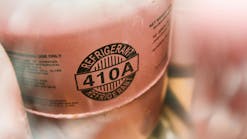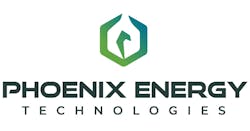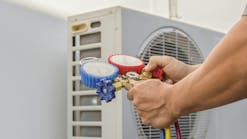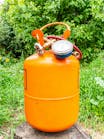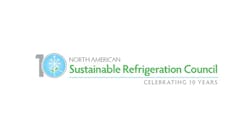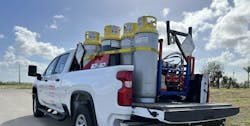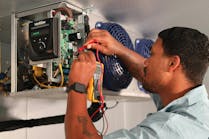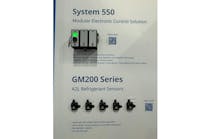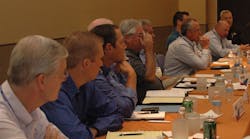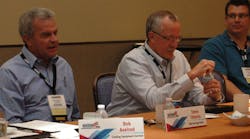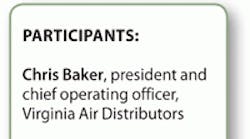Latest from Refrigeration
PART 3 OF A SERIES
Over the last several years, a number of daring supermarket retailers have been testing carbon dioxide refrigeration in conjunction with secondary loop and cascade systems.
- In Canada, for the first time in North America, as many as 40 Sobeys grocery stores have been outfitted with transcritical carbon dioxide (CO2) systems.
- Since June 2012, an Albertsons Supervalu store in Carpenteria, CA has been running on a combination of ammonia, CO2, and propane refrigeration systems.
- Manufacturers and end-users are actively discussing the future of alternatives to the longtime favorite gases in blogs, magazine articles, and trade show events.
Our 2012 Refrigeration Roundtable, held during Comfortech 2012, included a discussion of alternative refrigeration systems. Participating store executives brought some valuable insights based on recent installations, and contractor panelists shared their opinions on system performance, and adapting to change.
We started this discussion by asking, “Are natural refrigerants the future of the industry?”
Paul Anderson, engineering group manager of refrigeration for Target, said the future of any new technology begins with a willingness to consider an alternative.
“It’s important to consider all the systems we may have within our toolbox and apply them at the right time. That’s first and foremost the most important consideration,” Anderson said.
THE REFRIGERATION ROUNDTABLE WAS MADE POSSIBLE BY THE GENEROUS SUPPORT OF
EMERSON, HILL PHOENIX, AND DANFOSS.
“As far as impact to capital investment, with natural refrigerants or CO2 we’ve seen an increase for both installation and the equipment costs associated with these systems. Maintenance and repair costs have started out a little bit higher. We expect over the long term, that we’ll see parity as compared to an R404A direct expansion system. System uptime, or the way that we measure the store’s ability to keep product on the shelves during their open hours has been flat. The biggest impact has been on the carbon footprint. We’ve seen it decrease, in both direct and indirect carbon impact," shared Anderson.
Anderson said cascade CO2 systems are viable solutions, depending on the climate zones. "The transcritical systems are something we should be looking at. But it’s critical that you’re able to use the heat reclaim or waste heat," he cautioned. "I’ve seen a number of studies that have shown without the ability to use the waste heat, they’re not as efficient as a traditional or synth etic refrigeration system.
“It’s something we as an industry need to continue to investigate and consider, and then share the data as quickly as possible with the manufacturers, other retailers, and contractors, so they can train technicians, if necessary going forward.”
Brent Beishuizen, lead technician with Zone Mechanical, Chicago, IL, is impressed with a glycol, medium temp/CO2 system installed at a Walmart in Chatham, IL.
FOLLOW CONTRACTINGBUSINESS.COM ON TWITTER @CONTRACTINGBIZ
“The carbon dioxide ran great, right from the start. There were a few problems related to controllers, but once it was started, the cases ran great. After defrost, within 10 minutes it’s back down to temp. The primary refrigerant was R134A on medium temp and R407 on the CO2 side.”
Scott Martin, director of sustainable technologies for Hill PHOENIX, helped to bring the discussion into perspective by stating that with carbon dioxide, the industry is still maneuvering over what is very new terrain.
“Remember that we’ve only got six years of experience under our belt,” Martin said. “We’ve been building HFC and CFC systems for 50 years. We’ve become very good at building those systems cost effectively, and getting contractors trained on installing and servicing them, so they use the least amount of energy. We just cutting our teeth on CO2 equipment and technology,” he said. He believes there’s a promising future for acceptance of CO2, if the entire industry can pull together on development and application.
“The success of CO2 is going to be dependent on retailers, contractors, manufacturers of systems and components teaming in to make this happen. If we leave it to one company, it’s going to fail, because it’s new and different. These panelists are here because they’re aggressive and innovative. There are many more who say ‘I don’t want to change, don’t talk to me about new technologies.’ That can kill it if we don’t do a good job of training the naysayers.”
Glenn Barrett, director, business development for Danfoss, said improved valve technology is very welcome with CO2 usage.
“Electronic valves respond much faster than mechanical valves, and the thermal physical properties of CO2 are such that you need that fast reaction time,” Barrett said. “And, if you look at the design and layout of a transcritical system versus a subcritical cascade or a secondary system, transcritical is less complex than the others. That’s an advantage.”
Refrigeration contractor Steve Tibbetts, president, T&O Refrigeration, Fayetteville, GA, said the refrigeration industry’s field personnel has always proven its mettle in the face of change.
“I’ve been around long enough to install and work on R502 and R12. When we went to R22 and R404, it was a completely different animal for the installer and service technician. Then, we had to size lines properly, and set valves precisely for it to operate and work correctly. We’ve all managed to evolve to the equipment.
“Technicians will evolve, and the contractors will evolve to the equipment as it comes out. It might be a little tougher and may take a little longer and we may have to find unique guys to do it, but the training’s there,” Tibbetts added.
“For example, Hill PHOENIX does an excellent job on training. I took a CO2 class with them, and it was unbelievable. They offer anything you need to get where you need to be. And, as more new technology comes along, we’ll learn it. It’s going to be a little more costly, and we’re going to pay our people more, and rely on them more, but it will happen.”
Our 2012 Refrigeration Roundtable Panel of Experts
SUPERMARKET REPRESENTATIVES:
Jon Scanlon, director, refrigeration & energy, Hy-Vee,
West Des Moines, IA
Joe Galego, manager, refrigeration & HVAC BJ’s Wholesale Club, Westborough, MA
Howard Hehrer, senior engineer, Meijer, Walker, MI
Paul Anderson, engineering group manager, refrigeration, Target, Minneapolis, MN
Ted Alwine, director of engineering, Martin’s Supermarkets, South Bend, IN
CONTRACTOR REPRESENTATIVES:
Bob Axelrod, president, Cooling Equipment Service,
Chicago, IL
Brent Beishuizen, service manager, Zone Mechanical,
Chicago, IL
Jai Hoover, vice president, REMCO, Mechanicsburg, PA
Mike Martin, president, Carlson & Stewart, Marshall, MN
Ed Mattos, president, REMCO, Mechanicsburg, PA
Steve Tibbetts, president, T&O Refrigeration, Fayetteville, GA
SPONSOR REPRESENTATIVES:
Glenn Barrett, Jeff Staub, Danfoss
Al Maier, Tim Uderman, Kurt Knapke, Mike Saunders,
Sam Smith, Emerson Climate Technologies
Scott Martin, Derek Gosselin, Hill PHOENIX

